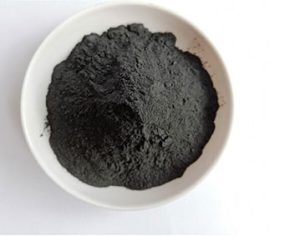Cobaltous Oxide
Cobaltous Oxide
Formula: CoO
CAS NO.: 1307-96-6
M.W.: 74.93
Features
A kind of odourless, insipid and black powder; insoluble in water, but soluble in hot inorganic acids.
Applications
Cobalt oxide is mainly used in horniness alloy, magnetic materials, enamel colouring and ceramics pigment.
Storage
Stored in cool and dry warehouse; Keep away from flame and heat.
| NO | Item | Specification | |
| 1 | Co | 76 min | 71-72 min |
| 2 | Fe | 0.1 max | 0.1 max |
| 3 | Ni | 0.3 max | 0.3 max |
| 4 | Zn | 0.1 max | 0.1 max |
| 5 | Mn | 0.2 max | 0.2 max |
| 6 | Cu | 0.1 max | 0.2 max |
| 7 | Pb | 0.006 max | 0.006 max |
| 8 | Size (through 200 mesh) | 98 min | 98 min |
Packaging Sizes
25kg net. Double plastic bags lined plastic woven sack.
What is cobalt oxide?
Cobalt oxide is a black-gray hexagonal powder. Relative density 5.18. Soluble in acid, insoluble in water, alcohol, ammonia. There are three cobalt oxides: cobalt oxide (CoO), cobalt tetroxide (Co3O4) and (Co2O3). Cobalt oxide is easily reduced to metallic cobalt by carbon monoxide. At high temperature, it is easy to react with silica, alumina or zinc oxide to form a variety of pigments.
Cobalt oxide is a low-valent oxide of cobalt, which appears gray-green, brown, pink, and dark gray due to different preparation methods and purity. Cobalt in cobaltous oxide can dissociate from oxygen at high temperature, and the dissociation pressure is 3.36×10-12 atmospheres at 1000℃. Under heating conditions, cobaltous oxide is easily reduced to elemental cobalt by H2, C or Co. Co2O3 is only stable when it is in a hydrated state, and this hydrate is dehydrated at 265 °C and transformed into an intermediate oxide tricobalt tetroxide (Co3O4). Cobalt oxide can be reduced to cobalt tetroxide (Co3O4) by H2 at 125°C, to CoO at 200°C, and to metallic cobalt at 250°C. Cobalt oxide is soluble in acid and alkali, but insoluble in water, alcohol and ammonia. A variety of pigments can be made by reacting cobalt oxide with silica, alumina or zinc oxide at high temperature.
Application of cobalt oxide:
①paint additives
The addition of cobalt oxide in the manufacture of paint can act as a catalyst, allowing the paint to dry quickly during use, improving application and performance. Facilitates rapid application of paint.
②Enamel and Ceramic Pigments
After adding the oxide drill to the enamel material, the wear resistance and corrosion resistance can be improved. In daily-use ceramics and other living building materials, cobalt oxide is used to make blue cobalt oxide pigments or glazes, so that the color of the ceramic products after burning paper is more conspicuous, and the ornamental and artistic quality is higher.
③Refined Petroleum Catalyst
Cobalt products play an important role in petroleum refining. Alloy catalysts are made of metal cobalt, aluminum, iron, etc.; the use of cobalt oxide as a petroleum catalyst is very important for accelerating petroleum refining.
④battery industry
Cobalt compounds such as cobalt powder and cobalt oxide powder are used as battery material additives with excellent performance, which can improve the proton conductance of Ni(OH)2, reduce the oxidation potential, increase the oxygen evolution potential, and have a significant effect on improving the electrode performance. In the early stage of charging, the electrode can be fully charged, so that Ni(OH)2 can be fully converted into NiOOH, and at the same time, the precipitation of oxygen can be suppressed, the charging efficiency can be improved, and the specific capacity of the electrode can be increased.
⑤Other product raw materials
Cobalt oxide is widely used as an intermediate raw material. Such as: reducing cobalt oxide with hydrogen at a certain temperature to produce metal cobalt powder, which is used to manufacture cemented carbide; using acid to dissolve cobalt oxide to make an aqueous solution for electrolysis to obtain metal cobalt ingots as an additive for high-temperature high-strength alloy steel; Cobalt salts, such as CoC2, CoS04, CoCo3 and CoC204, can be produced after different chemical processing. The use of cobalt oxide in the electrical industry such as additives for phosphors and other chemicals has also developed rapidly.
